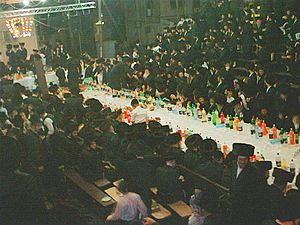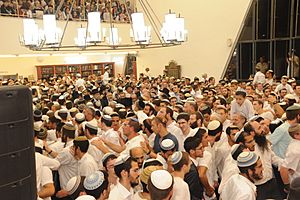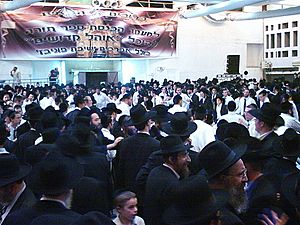Simchat Beit HaShoeivah facts for kids

Simchat Beit Hashoevah or Simchas Beis Hashoeiva (Hebrew: שמחת בית השואבה) means "Rejoicing of the Water-Drawing House." It is a special celebration held by Jewish people during the middle days of the Sukkot holiday. It's a time for great joy, music, and dancing.
Contents
Why We Celebrate Simchat Beit Hashoevah
When the Temple in Jerusalem stood a long time ago, a special event happened every morning during Sukkot. This was called the Nisukh HaMayim, or "Pouring of the Water" ceremony.
The Water Ceremony
The Talmud teaches that Sukkot is when God decides how much rain the world will get. So, the water ceremony, like using the Four Kinds of Plants, was a prayer for good rain at the right time. The water for this ceremony came from the Pool of Siloam in the City of David. It was then carried up a special road to the Temple. People felt very happy during this procession.
The Grand Celebration
After the water ceremony, every night, thousands of people would gather in the Temple courtyard. They came to watch the Simchat Beit HaShoeivah, which means "Rejoicing at the Place of the Water-Drawing." The most religious people would dance and sing songs to praise God.
The dancers held burning torches. Levite musicians played harps, lyres, cymbals, and trumpets. The Mishnah says, "Anyone who has not seen the rejoicing at the Place of the Water-Drawing has never seen true joy." During Sukkot, Jerusalem was full of Jewish families. They came for the holiday and celebrated with feasts and Torah study. A special screen was set up to separate men and women for this event.
One famous story tells of Rabban Shimon ben Gamliel. He was so joyful that he would juggle eight burning torches. He threw them up and caught them without any touching each other!
How It's Celebrated Today
Today, people remember this amazing event with their own Simchat Beit HaShoeivah parties. These gatherings include music, dancing, and snacks. They often happen in places like a synagogue or a yeshiva (a Jewish study center). Food is usually served in a sukkah (a temporary hut built for Sukkot). Live bands often play music for the dancers. The celebrations usually start late in the evening and can last for many hours into the night.
Simchat Beit Hashoevah in Jerusalem
In Jerusalem, many Hasidic synagogues hold Simchas Beis HaShoevah celebrations on most nights of Sukkot. The eastern part of Meah Shearim, a neighborhood, becomes very lively. Large festivals take place at synagogues like Karlin, Toldos Aharon, Toldos Avrohom Yitzchok, and Breslov. The biggest one is usually at Toldos Aharon. Other celebrations happen at the main synagogues of Dushinsky and Belz, plus many smaller places around the city.
See also
 In Spanish: Simjat Beit HaShoeiva para niños
In Spanish: Simjat Beit HaShoeiva para niños



